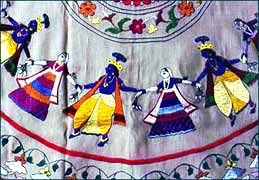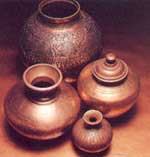| Encyclopedia of Tours and Travel to Himachal Pradesh, featuring information on Fairs & Festivals, Wildlife, Excursion, Adventure & Weather of Himachal Pradesh. |
 |
 |
 |
 |
 |
||||
|
Traditional Crafts
Isolated as they are, due to the high altitudes, the people of Himachal Pradesh are by and large, self contained and have developed through the years a rich tradition of handicrafts, totally original and distinctive. These range from wood-work to leather embroidery, metalwares to carpets and woolen textiles. New designs are being added to the traditional ones and new markets, both in India and abroad, are being discovered. Ready - Made Garments, Accessories &
Dolls The Chamba folk are extremely fond of adornment. Head scarves are worn by the women, and these are usually of bright printed cotton and knotted at the back. Bangles and rings made of horse hair are the typical accessories worn by the Chamba women. To climb blithely over the rocky hill-sides, the people wear sturdy grass shoes, comfortable and warm inside and brightly patterned on the outside. The local traditional costumes are reflected in the exquisite dolls made by the Himachalis. These beautiful and life-like figurines lend charm to modern environs. Shawls Movement in embroidery! The Chamba embroiderer has captured it on his rumals. It may be mischivious Krishna at his pranks stealing butter, or dancing with Radha. It may be a lamenting women parted from her lover, or people frolicking at a local fair. All are worked in fine detail with vivid silks and in constrasting colours. The art of embroidery is largely based upon the indigenous Kangra and Chamba schools of paintings. The stitches are so closeby, spaced that no gaps are visible. The word 'Rumal' may conjure up visions of a handkerchief to the layman but to the Chamba people, it is a form of adornment. Men drape these colourful embroidered rumals over their shoulders and the women use them as flowing veils. A Chamba rumal is such a priceless possession, that a bride's trousseau would be incomplete without it. Today, Chamba rumal are also used as wall-hangings, door and fire screens, cushion covers while the designs have been adopted for table-cloth and bed-spreads. Leather Craft
Today, in keeping with the modern trends, new varieties and designes of leather goods have been added to the traditional list, fancy shoes, sandals, embroidered leathers, socks and belts. Metal Crafts & Jewellery Jewellery is still a popular product of the Himachal silversmiths. And although the designs are still traditional, the ornaments are lighter and more practical. Modern innovations in the crafts include the making of intricately carved silver lamp stands, tea pots, wine or butter cups and metal scultpture. These follwo indigneious shpes and are decorated with finely carved patterns, which in addition to the local flora and fauna, depict stories from the epics. Carpets Paintings Wood Crafts & Wicker Works Woodcraft is an ancient traditional art prized for its delicacy and detail. Ancient treastises have been written on the subjects of carpentry and carving on wood. Wood workers occupied an esteemed - place in society for hey made the chariots for the warriors, and also drove them. Evidence of Himachal woodcraft is to be found in old buildings on seats, doors, windows and panels. Most notable was the Vice - regal Lodge at Shimla beautifully carved ceilings and panels. The present day wood work displays all the intricacy of the old. The main objects of work are fruit bowls, beer mugs, wooden jewellery and carved images, both romantic and mythological in origin. All along the crystal clear streams of Himachal grow the bamboo and the willow. When winter approaches, the hill people strip the bamboo. And when the country side is blanketed with snow they sit around cosy fires and fashion intricate and sturdy bowls, trays and baskets out of the dried bamboo. Oval-shaped, lotus-shaped or egg baskets with tall graceful handles are some of the typical basket patterns of Himachal Pradesh.
|
||||||||||
|
||||||||||
 ments.
The 'Gujjar' folk have a unique mode of dress, quite different from
the usual woollen sarees and gowns worn by the rest of Himachal
women. Gujjar men and women alike, wear a cotton shirt known as
"Kurta". Delicately embroidered with circular and linear
patterns, the 'Kurtas' are in deep colors. Interestingly enough
the lines and circles on the Kurta symbolise milk, and the dark
background the color of the buffalo.
ments.
The 'Gujjar' folk have a unique mode of dress, quite different from
the usual woollen sarees and gowns worn by the rest of Himachal
women. Gujjar men and women alike, wear a cotton shirt known as
"Kurta". Delicately embroidered with circular and linear
patterns, the 'Kurtas' are in deep colors. Interestingly enough
the lines and circles on the Kurta symbolise milk, and the dark
background the color of the buffalo.  nd
weave exceptionally fine and valuable shawls during winter, when
the fields are covered with snow. Mostly notable of these is the
soft Pashmina Shawl made from the hair of the Pashmina Goat. The
exquisite shawls of the Himachal are both plain and designed. The
colour of these, largely depend upon the wool, is mixed. The right
mixture can result in beautiful greys, blues, mustards and blacks.
If the designs of the Himachal Shawls are varied, so are also the
methods of wearing them. Every district has improvised its style
of drapping the shawl, the most popular styles being 'Dhobroo' and
'Pattu'.
nd
weave exceptionally fine and valuable shawls during winter, when
the fields are covered with snow. Mostly notable of these is the
soft Pashmina Shawl made from the hair of the Pashmina Goat. The
exquisite shawls of the Himachal are both plain and designed. The
colour of these, largely depend upon the wool, is mixed. The right
mixture can result in beautiful greys, blues, mustards and blacks.
If the designs of the Himachal Shawls are varied, so are also the
methods of wearing them. Every district has improvised its style
of drapping the shawl, the most popular styles being 'Dhobroo' and
'Pattu'.  ne
of the most ancient and developed crafts of Himachal Pradesh. the
traditional metals ar pure copper and silver. Local craftsmenship
in casting, ornamenting and engraving, show great skill, delicacy
and taste. Legend ha it that Sita, in the great Indian epic, the
Ramayana wore jewelled butterflies and other precious ornaments
in her hair and that these types of ornaments were made by the silversmiths
of Himachal Pradesh.
ne
of the most ancient and developed crafts of Himachal Pradesh. the
traditional metals ar pure copper and silver. Local craftsmenship
in casting, ornamenting and engraving, show great skill, delicacy
and taste. Legend ha it that Sita, in the great Indian epic, the
Ramayana wore jewelled butterflies and other precious ornaments
in her hair and that these types of ornaments were made by the silversmiths
of Himachal Pradesh.